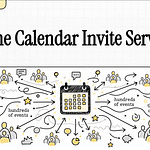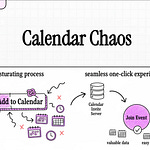Briefing Document: CalendarInvite.com Reinventing Calendar Invite
Event Communication
Date: August 30, 2025
Attendees: Greg, Arie
I. Executive Summary
This briefing summarizes a discussion between Greg and Arie regarding calendarinvite.com, their long-standing collaboration, and current efforts to leverage AI (specifically Notebook LLM) to process existing content and explore new market opportunities. The core of their invention revolves around the concept of a "headless create" for calendar invites, which hijacks existing calendar clients as a message layer, enabling programmatic embedding and scalable updates of time-based events. They believe this approach addresses significant shortcomings in traditional email-based event promotion and offers a more effective, user-centric solution for communicating large-scale events. The long-term vision is to position calendar invites as a "third channel" of communication, on par with email and SMS, for intent-driven and time-sensitive messaging.
II. Key Themes and Important Ideas
A. Leveraging AI for Content Generation and Discovery
Content Repurposing: Greg is actively using Notebook LLM to parse 30 chapters of content from GitHub, generating audio and video transcribes, FAQs, and mind maps, which are then published on calendarinvite.com. This content is specifically designed for AWS developers.
"I've been going through our content in GitHub, taking it to Notebook LLM and parsing out the 30 chapters of content. Um, and then building out an audio transcribe and then a video transcribe and then the content in the middle with the FAQs and then posting those up on calendarinvite.com."
AI for Content Visualization and Workflow Understanding: Notebook LLM is praised for its ability to "go verb" on how workflows operate and visualize the AWS stack, offering significant value to viewers.
"Notebook LLM does an incredible job with transcribing the FAQs. It does an amazing um I think value for a viewer around the mind map. You know it doesn't speculate anything. It goes verb. On how each workflow works and then visualizes it."
Exploring the "Rabbit Hole" of AI: The current year is viewed as a pivotal moment for utilizing AI in content creation, and the speakers emphasize the need to engage directly with these tools to understand their full potential.
"It's like everybody in this current year is going through this generation of using AI, at least with notebook LLM, to figure out content. But I don't think you'll know unless you get through the hole yourself, the rabbit hole."
B. The "Headless Create" and Hijacking the Calendar Client
Core Invention: The fundamental innovation is the "headless create" of calendar invites. Instead of relying on traditional forms of authentication, the system leverages the existing calendar client (Google, Outlook) as a message layer.
"Everything appears extremely simple, right? People are used to forms. We initially said we didn't need forms. We said people are used to logging in. Oh, we don't need login. We have all the offending. You know, you're using the calendar client, right? So, nobody can hijack anything because we're not allowing them to hijack it."
Simplifying Authorization: By "hijacking the invite as a message layer," the need for complex OAuth or other authorization hurdles is eliminated. Users invite one email address, and the system processes it.
"If you're using that and we hijack the invite as a message layer into the calendar invite server, then all of a sudden, now I don't have to jump hurdles on uh OATH or anything else, right? I don't have to authorize who I am. I sent it in. I invite one email address, and it goes in, and then it does its thing."
Discovery Jewels (Create and Send): Specific functionalities, such as "create" (disassembly and reassembly of components on the fly for Apple and Google) and "send" (programmatic embedding of calendar invites in web pages or Python scripts for batch processing), are highlighted as key innovations.
"Create unto itself is an invention you know, disassembly you know of the components on the fly for Apple and Google and then the reassembly on the fly is also a really amazing thing for the UID to be you know pulled out of a database and matched to the Arie box you know to email address and then a calendar invite to be sent out."
C. Calendar Invite as a Dynamic Messaging Layer
Beyond Static Invites: The system allows for dynamic updates to calendar invites, enabling organizers to communicate changes (date, time, location, subject) or even promotional content directly to attendees who have accepted the invite.
"If you look mechanically in a workflow, like once it's on their calendar during that live, I mean, what you're teasing out here is we actually do have a dynamic messaging layer when the event span is live and they do have it on their calendar. The organizer can change anything, and they will receive an automatically updated calendar. Pushes to those people downstream that have said yes or maybe."
"Trojan" RSVP Button: The embedded RSVP button acts as a "Trojan" in emails, implanting the calendar invite on the user's calendar. This then allows for downstream communication and updates directly through the calendar.
"You have a Trojan, if you will, the button, the RSVP button is implanted in the emails, um basically OEM, you know, say Mailchimp. So, you put the button in there, they click it, they get the calendar invite, and then the organizer... has the calendar snack originated on their calendar. Then they could communicate to those people downstream directly by sending an update..."
Container of Time, Intent, and Commitment: The calendar invite is framed as a powerful communication tool because it signifies time, intent, and commitment from both the organizer and the invitee. This differentiates it from emails, which are less effective at establishing intent.
"The whole stream of consciousness of its time, intent, and commitment, right? So, once you start sending an invitation based on that flow, the event itself has a specific time if you want to consume it live. That's the perfect example of a complicated data set because multiple games are going on at multiple times."
"Email is awesome for communicating, but it's not good at creating any intent or commitment. It's not good at the time..."
D. Scalability and Market Opportunity
Cloud Scale (AWS Serverless): The solution is built on an AWS serverless stack, allowing for millions of calendar invite sends and updates with ease.
"It could scale to millions quite easily because it's on the AWS principled stack of serverless."
Addressing "Email Death Marches": The current practice of sending multiple reminder emails (also known as "email death marches") for events is viewed as inefficient and annoying. Calendar invites offer a more effective and less intrusive way to communicate time-based information.
"You're sending me constant emails about the same thing. It was never on my calendar. Oh, you gave me an ad to the calendar, but it didn't work. You pissed me off."
Third Channel of Communication: Calendar invites are positioned as a distinct and valuable communication channel, alongside email and SMS, especially for time-based and intent-driven interactions.
"It's a third, it's a third rail, third channel, whatever you want to call it, but it's like it's at the same level from a messaging perspective as email, SMS, and calendar invite, right?"
OEM Strategy for Go-to-Market: The preferred go-to-market strategy is through OEM partnerships with large email marketing platforms (Mailchimp, HubSpot, SendGrid) or cloud providers (AWS, Google, Microsoft) that already have massive user bases and list management capabilities.
"A better takeout strategy would be, you know, an OEM that has compassion and commitment around, like you said, the install base. They already have an install base."
Targeting Global Brands and Event Marketing: The solution has significant potential for global brands, sports marketing, and digital marketing agencies that manage numerous events and promotions.
"The crossover in brand management would be someone like global brands, you know, Red Bull, Nike, it doesn't matter, you know, Liquid Death..."
"There's a segment in sports marketing in particular globally or Red Bull or say events in general on sports, regarding you know, like we're in the middle of it now, you know, with ESPN sports..."
E. Contrast with Existing "Add to Calendar" Solutions
User Experience Failure: The current "add to calendar" buttons are criticized for being clunky, requiring multiple steps, often leading to dead ends, and failing to provide a seamless user experience, particularly across different calendar clients.
"You know the ad to calendar was you know four buttons, and I'm a Google user, and then you know I was in Google logged in, and then it goes to an email dead-end, you know, landing page."
Lack of Post-Commitment Communication: Existing solutions often fail to allow for updates or further communication after an event is added to a calendar.
"The rest of the story was never told, which was, hey, organizer, when you know, our tech came together on the updater, you know, you could actually promote even more once it's on their calendar, right?"
III. Key Facts and Figures
Project Name: calendarinvite.com
Current Development Phase: Processing 30 chapters of content from GitHub using Notebook LLM.
Target Audience for Content: AWS developers.
Core Technology: AWS serverless stack.
Scalability: Capable of sending and updating millions of calendar invites.
Cost: "Per million cents, you know, 29 cents."
Install Time (for OEM): Potentially "one week" to roll out to users.
Market Hypothesis: At least half of the "trillions" of emails sent monthly globally are time-based.
Initial Design Intent: Not intended for 2500+ events, but for users hosting around 100 events per year, although it currently supports large-scale events (e.g., 2500 MLB events, 800 NBA events).
Current Metrics (for button test): Data collected from 5,000-10,000 calendar invites sent, with a "pretty decent pickup rate."
IV. Challenges and Future Considerations
Marketing and Go-to-Market Strategy: The overwhelming nature of reaching billions of users and getting the technology into the hands of major OEM partners is a significant challenge.
Imposter Syndrome: The inventors acknowledge the feeling of "imposter syndrome" when realizing the potential scale and impact of their invention.
"The impostor part is, oh, it can't be f****** right that, you know, you invented something so good that f****** Mailchimp could use.”*
Educating the Market: Shifting ingrained communication habits away from traditional email-only promotions will require educating large brands and marketing professionals on the value of calendar invites as a dynamic channel.
Data Ingest for Mass Events: Exploring alternative vehicles for ingesting large volumes of event data (e.g., 250,000 events in a robotic sweep) that may not go through the calendar client.












